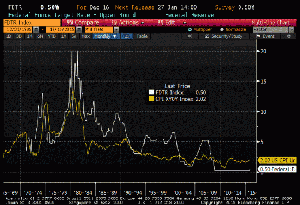Mike Ashton, of Enduring Investments LLC, examines past tightening cycles to stress the importance of always remembering that anyone who says he knows with absolute certainty what’s going to happen to stocks, bonds, the USD, commodities, or anything else… is relying on astrology.
Some days make me feel so old. Actually, most days make me feel old, come to think of it; but some days make me feel old and wise. Yes, that's it.
It is a good time to remember that there are a whole lot of people in the market today, many of them managing many millions or even billions of dollars, who have never seen a tightening cycle from the Federal Reserve. The last one began in 2004.
There are many more—managing many more dollars—who have only seen that one cycle, but not two; the previous tightening cycle began in 1999.
This is more than passing relevant. The people who have seen no tightening cycle at all might be inclined to believe the hooey that tightening is bullish for stocks because it means a return to normalcy. The people who have seen only one tightening cycle saw the one that coincided with stocks' 35% rally from 2004-2007. That latter group absolutely believes the hooey. The fact that said equity market rally began with stocks 27% below the prior all-time high, rather than 32% above it as the market currently is, may not have entered into their calculations.
On the other hand, the people who dimly recall the 1999 episode might recall that the market was fine for a little while, but it didn't end well. And you don't know too many dinosaurs who remember the abortive tightening in 1997 in front of the Asian Contagion and the 1994 tightening cycle that ended shortly after the Tequila crisis.
Moreover, it is a good time to remember that no one in the market today—or ever—can remember the last time the Fed tightened in an "environment of abundant liquidity," which is what they call it when there are too many reserves to actually restrain reserves to change interest rates. That's because it has never happened before. So if anyone tells you they know with absolute certainty what is going to happen, to stocks, or bonds, or the dollar, or commodities, or the economy, or inflation, or anything else…they are relying on astrology.
Many of us have opinions and some more well informed than others. My own opinion tends to be focused on inflationary dynamics and I remain very confident that inflation is going to head higher not despite the Fed's action Wednesday, but because of it. I want to keep this article short because I know you have a lot to read, but I will show you a very important picture (source: Bloomberg) that you should remember.
NEXT PAGE: The Effect That Happens Almost Instantly
|pagebreak|The white line is the Federal Funds target rate (although that meant less at certain times in the past, when the rate was either not targeted directly, as in the early 1980s, or the target was represented as a range of values). The yellow line is core inflation. Focus on the tightening cycles: in the early 1970s, in the late 1970s, in 1983-84, in the late 1980s, in the early 1990s, in 1999-2000, and the one beginning in 2004. In every one of those episodes, save the one in 1994, core inflation either began to rise or accelerated, after the Fed began to tighten.
The generous interpretation of this fact would be that the Fed peered into the future and divined that inflation was about to rise and so moved in spectacularly-accurate anticipation of that fact. But we know that the Fed’s forecasting abilities are pretty poor. Even the Fed admits their forecasting abilities are pretty poor. And, as it turns out, this phenomenon has a name. Economists call it the “price puzzle.”
If you have been reading my columns, you know this is no puzzle at all for a monetarist. Inflation rises when the Fed begins to tighten because higher interest rates bring about higher monetary velocity, because velocity is the inverse of the demand for real cash balances. That is, when interest rates rise you are less likely to leave money sitting idle; therefore, investors and savers play a game of monetary hot potato which gets more intense the higher interest rates go…and that means higher monetary velocity. This effect happens almost instantly. After a time, if the Fed has raised rates in the traditional fashion by reducing the growth rate of money and reserves, the slower monetary growth rate comes to dominate the velocity effect and inflation ebbs. But this takes time.
And, moreover, as I have pointed out before and will keep pointing out as the Fed tightens: in this case, the Fed is not doing anything to slow the growth rate of money, because to do that they would have to drain reserves and they don’t know how to do that. I expect money growth to remain at its current level or perhaps even to rise as higher interest rates provoke more bank lending without and offsetting restraint coming from bank reserve scarcity. By moving interest rates by diktat, the Fed is increasing monetary velocity and doing nothing (at least, nothing predictable) with the growth rate of money itself. This is a bad idea.
No one knows how it will turn out, least of all the Fed. But if market multiples have anything to do with certainty and low volatility, then we might expect lower market multiples to come.
Michael Ashton, Managing Principal, Enduring Investments LLC






















